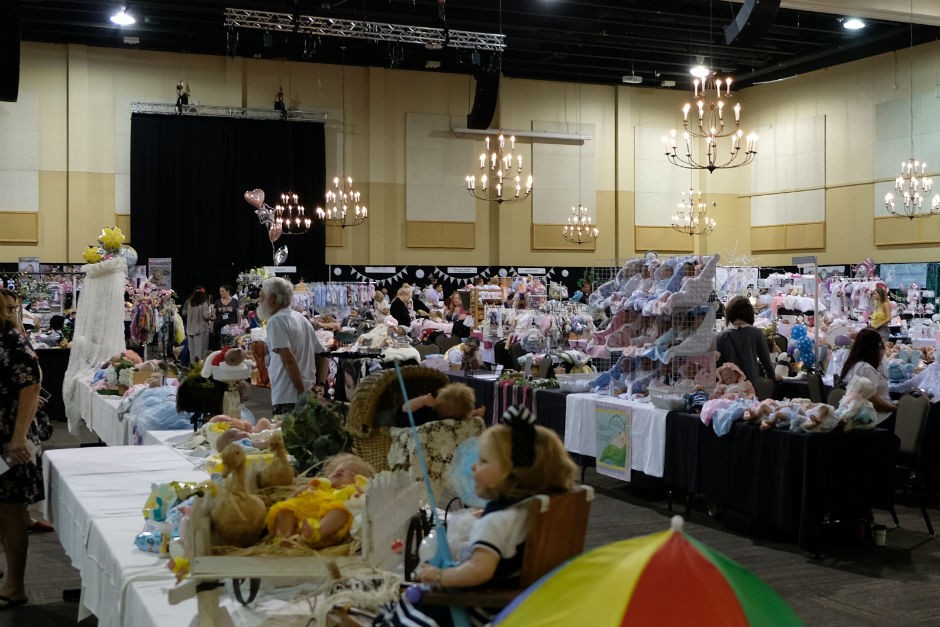Emilie St-Hilaire is a multidisciplinary artist and doctoral candidate in Concordia’s Humanities PhD program. She is studying the idiosyncratic and widely misunderstood practice of reborn doll collecting from a feminist perspective. She has published in the journal RACAR on the topic of research-creation and has exhibited her artwork at galleries and festivals nationally and internationally. Her doctoral research has been supported by scholarships from the FRQSC, Concordia University, Hexagram Network and Francofonds.
 The 2018 ROSE International Doll Expo in Layton, Utah. | Photo by Emilie St-Hilaire
The 2018 ROSE International Doll Expo in Layton, Utah. | Photo by Emilie St-Hilaire
Children need to play, it’s how they learn. We similarly encourage adults entering their senior years to partake in activities that stimulate intellectual engagement to stave off Alzheimer’s and dementia. But what about everyone else? ‘Get a hobby’ is an uncharitable piece of advice for someone who appears to be wasting their time on an unproductive activity. Let’s think about that for a minute.
After the Industrial Revolution, hobbies were established as a category of leisure in order to distinguish a good pastime from a bad one. Guardians of public morality were interested in discouraging useless or morally dangerous activities. During the Great Depression, for example, the under-employed had extra time on their hands and those with jobs had less cash to spare, prompting a need for cheaper leisure activities.
Through fulfilling hobbies, citizens could exercise skills and attitudes that would make them more productive. The belief was that hobbies brought the best aspects of work into the world of leisure.
This blurring of the boundaries between work and leisure from the Depression era is an uncanny reversal of what today’s ‘creative economy’ models. Now, young entrepreneurs are encouraged to cash in on their passion in order to bring the best aspects of their hobbies into their work. A major difference is that in the latter model, one ends up with no hobby.
Hobbies as escape
William C. Menninger offers a different perspective on hobbies. He argues that although it may seem paradoxical to urge the cultivation of hobbies amid long work hours, the pressures of higher production, night shifts and increased responsibilities, these conditions in fact create an even greater need for relaxation, escape, and recreation.
What was this time of unrest and anxiety? It was 1942, and Menninger, an American medical doctor, was hoping to contribute to healthy civilian morale amid the war efforts by encouraging adults to have hobbies. Menninger informed his readers that the American Psychiatric Association says individuals require a certain amount of recreation and rest since they’re not machines.
Menninger’s prescription was to do something significantly different from your work, and which you enjoy doing. Your hobby should be so different from your work that you forget your work while engaged in the recreation activity.
Although many people, and presumably some of you reading this, identify with the pressures of long work hours, high expectations for productivity and feelings of unrest or anxiety in our current time, I hesitate to make a comparison to the stresses of life during the Second World War. That said, we aren’t any more machine-like than we were in the 20th century, no matter how advanced the gadgets we use to quantify our productivity.
We need periods of rest and relaxation, particularly to escape the ubiquitous digital technologies that allow us to work from anywhere.
Reborn dolls, a therapeutic hobby
In my research, I’m working to determine whether doll collecting is more of a hobby or a therapeutic activity. The dolls I’m interested in are not the made-for-display little porcelain ladies so often in frilly dresses with matching hats and long curls.
I study reborn babies, which are hyper-realistic vinyl or silicone dolls made to resemble real infants as much as possible. They’re weighted to feel like a baby in your arms, and they can wear real baby clothes.
I'm looking at many facets of this subcultural phenomenon as part of my interdisciplinary doctoral dissertation. I won’t go into detail here but if you would like to know more, check out my WordPress blog called Reborn Baby Talk.
Reborns are comforting and can help treat anxiety, stress and bereavement. Researchers are studying doll therapy (with overwhelmingly positive results) as a non-pharmacological intervention for people living with Alzheimer’s and dementia.
Most articles and viral videos that circulate about reborns mention these therapeutic justifications, but they almost always fail to mention the more hobby-like aspects of reborn collecting. It’s just so hard to conceive of adults enjoying dolls that it becomes easier to imagine tens of thousands of women grieving their lack of real babies by adopting large quantities of dolls.
Hobbies and gender
I’ve twice attended a doll show in the US where reborn enthusiasts gather with their favourite reborn babies to socialize and browse the vendor tables. The atmosphere is festive and very welcoming. The event is like any hobby trade show in many respects. Reborns are a uniquely therapeutic hobby, but isn’t there a therapeutic aspect to all hobbies?
If hobbies can offer creative fulfillment, social recognition and a sense of personal control (as described by historian Steven Gelber), then we should seriously consider hobbies as a coping mechanism amid modern day stresses. Perhaps not to the extent of hobby as escapist fantasy (which I do question sometimes in regards to reborn play), but as a way to get by.
If you’ll indulge my proposition that hobbies are a valuable tool for mental health, then I have a favour to ask. Please try to be open-minded about the hobbies people choose. Consider the following list of hobbies, and note who you envision engaging in each activity:
- Stamp collecting
- Gun collecting
- Dollhouses and miniatures
- Model trains
- Needlework (knitting, cross-stitching, quilting, etc.)
- Bone collecting
- Doll collecting
- Playing with dolls (dressing, cuddling, photographing)
- Historical reenactment
- Dungeons & Dragons
- Contact improv jamming
- Barbershop quartet
- Bridge or other card games
- Mandala colouring
- Graffiti painting
The term hobby came about at a time when good pastimes were morally sanctioned ways of spending one’s time. Let’s not allow antiquated and gendered ideas about age-appropriate play prevent individuals from accessing a fulfilling activity due to the stigma they will face among family and friends.
I can’t think of a hobby that goes viral more often than reborns. When it does, the public response is overwhelmingly harsh. Unless someone’s hobby is causing any actual harm, just live and let live. And seriously, get a hobby!
About the author


